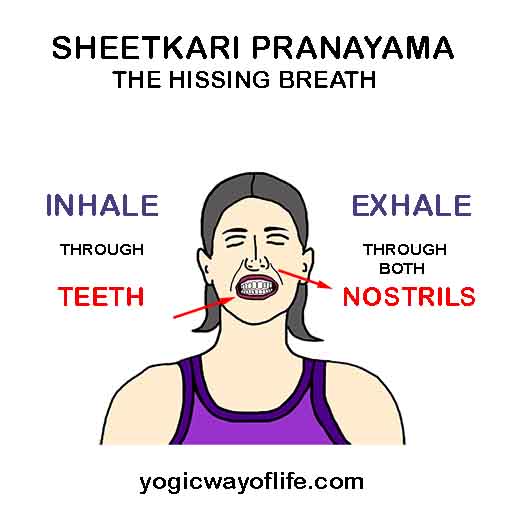Sitkari Pranayam or Sheetkari pranayama is also called the hissing breath. While performing it the sound of “see” or “seet” is made during inhalation. Kari is a Sanskrit word that means “that which produces” [1]. Thus, this practice is named so because it produces the see sound. Sitkari pranayama has a strong effect on cooling the body.
It is also believed in yogic circles that by the perfection of this pranayama one can become the master or controller of one’s desires (Kamadeva). Also, physical beauty and appearance are enhanced.
Mention in Scriptures
In Hatha Pradipika, Svātmārāma talks about this practice in the following verses, revealing the method, powers, and secrets associated with this practice.

Translation: “Seetkari is performed by drawing in the air through the mouth, keeping the tongue between the lips. The air thus drawn in should not be expelled through the mouth. By practicing in this way, one becomes next to the God of Love in beauty” [2]

Translation: “He is regarded adorable by the Yogins and becomes the destroyer of the cycle of creation, He is not afflicted with hunger, thirst, sleep, or lassitude” [1].

Translation: “The Satwa of his body becomes free from all the disturbances. In truth, he becomes the lord of the Yogis in this world” [2].
Procedure
Beginner Method
- Sit in a comfortable meditative posture. You can sit on a chair or in padmasana or siddha asana.
- Your spinal cord and head should be erect, and the hands should rest on the knees in chin or jnana mudra.
- Now close your eyes and relax your whole body. Calmly observe your breath for a minute to relax and center yourself.
- Now press your lower and upper teeth together, also separate your lips as much is possible and comfortable (Fig. 1).
- Next, inhale slowly through the gaps in your teeth.
- Listen to the sound your breath makes as it passes through the gaps of your teeth.
- Now close your mouth at the end of the inhalation and exhale slowly through the nose.
- Repeat the above process 10 to 20 times. This completes 1 round.

Advance Method
- Repeat the steps as performed in Beginner Method, but after the inhalation, hold your breath.
- Then perform Jalandhara bhanda and Moola bandha
- Hold these two bandhas as long as you feel comfortable.
- First release Moola bandha and then Jalandhara bhanda and exhale the breath out slowly through your nose with your head straight.
- Repeat the above process 10 to 20 times. This completes 1 round.
Duration
As a beginner practice 3 to 5 rounds. As you advance in your practice you can practice up to 9 to 15 rounds. Gradually increase your duration of inhalation and exhalation.
In hot weather, it is beneficial to perform this pranayama more times.
Time of Practice
Seetkari Pranayama can be performed any time during the day. It is preferable to perform it after asana practice or other yogic practice like bhastrika as the body is heated, and this helps in cooling down.
Sitkari Pranayama Precautions
- People with sensitive teeth, missing teeth or dentures should avoid this practice. They can instead to sheetali pranayama.
- This pranayama should not be performed during cold weather as it reduces the body temperature.
- It should not be practiced in a dirty and polluted atmosphere. Since the air breathed through the mouth bypasses the natural filtration mechanism of the nose, direct exposure to dirty air could harm the lungs.
- People suffering from the following diseases should not perform this pranayama:
- Low blood pressure
- Asthma
- Bronchitis
- Excessive Mucus
- Heart disease (can practice less rounds, also without breath retention)
- People suffering from chronic constipation or gastric problems should avoid this practice as this pranayama reduces the heat produced in the digestive system.
Sitkari Pranayama Benefits
- It helps in calming and cooling down the body and the mind.
- It influences the centers of the brain linked with biological drives and desires. One is able to have more control over sexual desires and vital energy.
- It helps in cooling emotional excitation and anger.
- It can be used before sleeping to tranquilize the mind and help in insomnia.
- It helps in unblocking the flow of prana through the body.
- It helps in reducing blood pressure.
- It helps in reducing acidity and hyperacidity
- It helps in reducing hunger pangs
- It helps in balancing excessive pitta dosha
- It helps in relieving anxiety and hypertension.
- It helps in strengthening the gums.
- It helps in harmonizing the endocrine system and the regulation of hormonal secretions.
References
- Book: Hatha Yoga Pradipika commentary by Swami Muktabodhananda.
- (All the verse translations in the article are by Pancham Sinh) Book: Hatha Yoga Pradipika Translated by Pancham Sinh.
- Book: The science Of Pranayama by Sri Sivananda.
- Book: Light on Pranayama by B.K.S Iyengar.
- Research Paper: Impact of Sheetali and Sheetkari Pranayama on the Topographic Mapping of the Brain Waves [link].

1 thought on “Sitkari Pranayama (hissing breath) – Meaning, Procedure, Benefits, Precautions”